![]()
![]()
![]()
Use LEFT and RIGHT arrow keys to navigate between flashcards;
Use UP and DOWN arrow keys to flip the card;
H to show hint;
A reads text to speech;
41 Cards in this Set
- Front
- Back
|
What are all the topics for exam 2? |
- Improper Integrals - Areas Between Curves - Volumes - Volumes with Cylindrical Shells - Arc Length - Applications to Physics and Engineering - Sequences |
|
|
What makes an improper integral divergent vs convergent? |
If it doesnt evaluate to a real number when you evaluate its limits its divergent, if it does evaluate to a real number its convergent |
|
|
How do you solve an improper integral problem? |
1. Solve the integral 2. Plug in the upper bound and the lower bound 3. If its limit evaluates to a real number then it is convergent, if it doesnt then its divergent |
|
|
Example 1 if an improper integral problem |
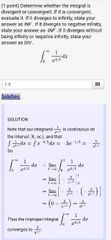
|
|
|
Example 2 of an improper integral problem |
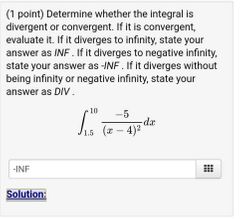
|
|
|
Example 3 of an improper integral |
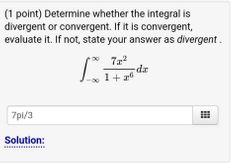
|
|
|
What is the formula for the area between curves? |

f(x) - top/right function, g(x) - bottom/left function. Test which is which by plugging in values within the interval. |
|
|
What do you do when an area between curves problem that consists of 2 parts? |
1) find the point of intersection by making the functions equal to each other and then solving for x, this is how you know where the functions make the switch. 2) set up the intervals: upper bound <=> intersection point & intersection point <=> lower bound. 3) plug in values for these intervals to see which is on top and which is on bottom for both 4) set up 2 integrals for each region and add them together |
|
|
Example 1 of area between curves |
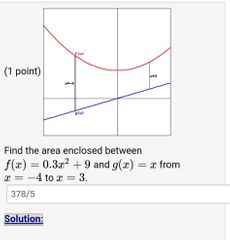
|
|
|
Example 2 of area between curves problem |
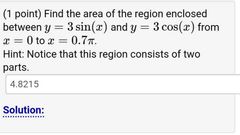
|
|
|
Example 3 of area between curves problem |
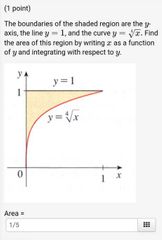
|
|
|
What is the equation for finding the volume of a shape found by rotating an area between functions? |

|
|
|
What does A(x) represent in the volume equation? |

|
|
|
What is the equation for volume when there are two functions used as parameters for the area? |

|
|
|
How do you solve an equation for volumes? |
1) determine which variable (x or y) the equation will be placed in 2) find the upper and lower bound of the integral, if in terms of x then this will be the range of the volume, if in terms of y then the domain of the area will be used 3) take the function(s) and plug it into the volume equation ( integral b/d <=> a/c pi(R^2 - r^2) dx/dy) * if in y terms then R is the the rightmost functuon, if in x then R is the top function 4) solve the integral |
|
|
How can you tell which terms a volume problem will be in? |
If "about the y-axis" in terms of y If "about the x-axis" in terms of x |
|
|
Example 1 of volumes problem |
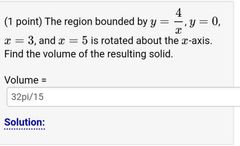
|
|
|
Example 2 of Volumes |
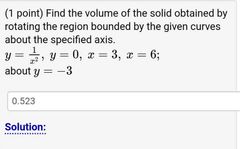
|
|
|
If the volume is rotated around something bigger than the x-axis or the y-axis then what must you do? |
Modify the integral equation to Subtract both radiuses from whatever the value is that its rotating around |
|
|
Example 3 of volumes problem |
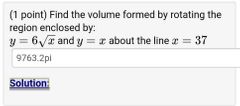
|
|
|
How do you find the volume of a circular disc? |
1) determine the radius and plug it into the equation for a circle: x^2 + y^2 = r^2 2) solve for y and then multiple by 2 3) plug it into an integral with the upper bound = r and the lower = -r |
|
|
How do you find the volume of a frustrum of a pyramid? |
... |
|
|
How do you find the volume of a frustrum of a right circular cone? |
... |
|
|
What is the equation for finding the volume using the cylindrical shell method? |
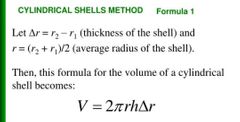
|
|
|
What is the equation for finding the volume using the cylindrical shell method? |
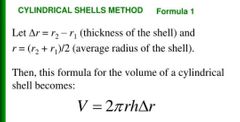
|
|
|
Example 1 of volume with cylindrical shell problem: |
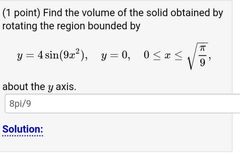
|
|
|
Example 2 of volumes using cylindrical shells problem |

|
|
|
Example 3 of volume using cylindrical shells problem |

|
|
|
How do you solve an arc length problem? |
1) determine the domain (if in terms if x) or range (if in y) to find the upper and lower bound of the integral and the derivative of the curve 2) plug these into the arc length equation and solve |
|
|
Example 1 of an arc length equation |
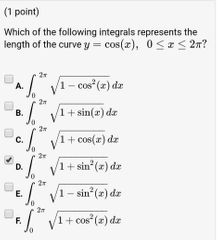
|
|
|
Example 2 of an arc length problem |
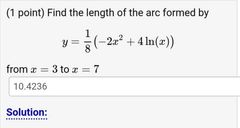
|
|
|
Example 3 of an arc length problem |
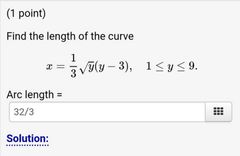
|
|
|
What is the formula to find work? |
Force × distance |
|
|
What is the formula for force? |
Mass × acceleration |
|
|
What is Hookes law? |

K = a constant when you divide the specific amount of force by a specific amount of stretch or compression |
|
|
What are equations youll potentially need for mass problems |
Force = mass × acceleration Mass = density × volume Acceleration is usually 9.8 m/s^2 Volume will depend on shapes in problem |
|
|
Example 1 of a physics application problem |
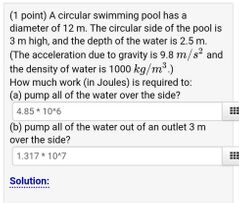
|
|
|
Example 2 of a physics application problem |
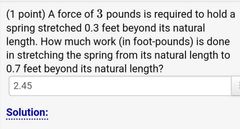
|
|
|
Example 3 of a physics application problem, |
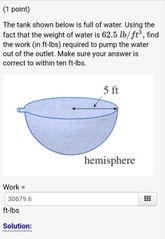
|
|
|
What is a sequence? |
A series of numbers that follow a formula |
|
|
How do you solve a sequence problem? |
Either find a pattern if the problem asks for one or evaluate the sequence like it is a limit to see if it converges. Divide by the largest degree in the denominator and evaluate each term to infinity |

